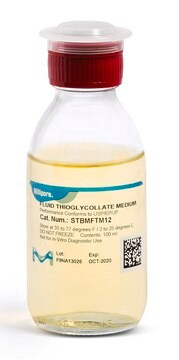1.07179
Pentane
for spectroscopy Uvasol®
Synonyme(s) :
Pentane
About This Item
Produits recommandés
Densité de vapeur
2.48 (vs air)
Niveau de qualité
Pureté
≥99.5% (GC)
Forme
liquid
Température d'inflammation spontanée
500 °F
Puissance
>2000 mg/kg LD50, oral (Rat)
Limite d'explosivité
~8.3 %
Technique(s)
UV/Vis spectroscopy: suitable
Impuretés
≤0.0002 meq/g Acidity
≤0.0002 meq/g Alkalinity
≤0.005% Water
Résidus d'évap.
≤0.0002%
Couleur
APHA: ≤10
Transmittance
200 nm, ≥50%
210 nm, ≥70%
215 nm, ≥85%
225 nm, ≥95%
240 nm, ≥98%
Indice de réfraction
n20/D 1.358 (lit.)
Point d'ébullition
35-36 °C (lit.)
Pf
−130 °C (lit.)
Température de transition
flash point -48 °C (refers to pure substance)
Solubilité
0.4 g/L
Densité
0.626 g/mL at 25 °C (lit.)
Absorption UV
λ: 200 nm Amax: ≤0.30
λ: 210 nm Amax: ≤0.16
λ: 215 nm Amax: ≤0.07
λ: 225 nm Amax: ≤0.02
λ: 240 nm Amax: ≤0.01
Température de stockage
2-30°C
Chaîne SMILES
CCCCC
InChI
1S/C5H12/c1-3-5-4-2/h3-5H2,1-2H3
Clé InChI
OFBQJSOFQDEBGM-UHFFFAOYSA-N
Vous recherchez des produits similaires ? Visite Guide de comparaison des produits
Catégories apparentées
Description générale
Application
- Quantitative determination of nitrous oxide in human blood by HS-GC-MS: forensic application of two fatal poisoning cases.: This study leverages n-Pentane in headspace gas chromatography-mass spectrometry (HS-GC-MS) for the forensic analysis of nitrous oxide in human blood. Highlighting its importance in forensic science, the research demonstrates n-Pentane′s utility in providing accurate and reliable measurements essential for legal and medical evaluations (Li Z et al., 2024).
- A photochromic trinuclear dysprosium(iii) single-molecule magnet with two distinct relaxation processes.: This article describes the use of n-Pentane in the synthesis of a dysprosium-based single-molecule magnet, showcasing its role in developing materials with unique magnetic properties for potential applications in quantum computing and data storage (Rogacz K et al., 2024).
- Reduction of Thorium Tris(amido)arene Complexes: Reversible Double and Single C-C Couplings.: This research employs n-Pentane in the study of thorium complexes, providing insights into reversible carbon-carbon coupling reactions. The findings contribute to the understanding of actinide chemistry and its application in recycling and waste reduction strategies (Deng C et al., 2024).
- Tuning Reactivities of tert-Butyllithium by the Addition of Stoichiometric Amounts of Tetrahydrofuran.: The study utilizes n-Pentane to adjust the reactivity of tert-butyllithium, illustrating its significant role in enhancing the control over chemical reactions. This advancement is pivotal for the synthesis of complex molecules in pharmaceuticals and materials science (Kleinheider J et al., 2024).
- Steps to achieve carvone-rich spearmint (Mentha spicata L.) essential oil: a case study on the use of different distillation methods.: In this research, n-Pentane is examined for its efficacy in extracting high-quality essential oils from spearmint, demonstrating its versatility in botanical extractions and its impact on the quality and characteristics of the essential oils obtained (Moradi-Sadr J et al., 2023).
Remarque sur l'analyse
Evaporation residue: ≤ 0.0002 %
Water: ≤ 0.005 %
Colour: ≤ 10 Hazen
Acidity: ≤ 0.0002 meq/g
Alkalinity: ≤ 0.0002 meq/g
Fluorescence (as quinine at 254 nm): ≤ 1.0 ppb
Fluorescence (as quinine at 365 nm): ≤ 1.0 ppb
Transmission (at 200 nm): ≥ 50 %
Transmission (at 210 nm): ≥ 70 %
Transmission (at 215 nm): ≥ 85 %
Transmission (at 225 nm): ≥ 95 %
Transmission (from 240 nm): ≥ 98 %
Absorbance (at 200 nm): ≤ 0.30
Absorbance (at 210 nm): ≤ 0.16
Absorbance (at 215 nm): ≤ 0.07
Absorbance (at 225 nm): ≤ 0.02
Absorbance (from 240 nm): ≤ 0.01
Meet the requirements of "Specific use spectroscopy" according Reag. Ph Eur
Autres remarques
Informations légales
Produit(s) apparenté(s)
Mention d'avertissement
Danger
Mentions de danger
Conseils de prudence
Classification des risques
Aquatic Chronic 2 - Asp. Tox. 1 - Flam. Liq. 2 - STOT SE 3
Organes cibles
Respiratory system
Risques supp
Code de la classe de stockage
3 - Flammable liquids
Classe de danger pour l'eau (WGK)
WGK 2
Point d'éclair (°F)
-40.0 °F
Point d'éclair (°C)
-40 °C
Certificats d'analyse (COA)
Recherchez un Certificats d'analyse (COA) en saisissant le numéro de lot du produit. Les numéros de lot figurent sur l'étiquette du produit après les mots "Lot" ou "Batch".
Déjà en possession de ce produit ?
Retrouvez la documentation relative aux produits que vous avez récemment achetés dans la Bibliothèque de documents.
Les clients ont également consulté
Notre équipe de scientifiques dispose d'une expérience dans tous les secteurs de la recherche, notamment en sciences de la vie, science des matériaux, synthèse chimique, chromatographie, analyse et dans de nombreux autres domaines..
Contacter notre Service technique








